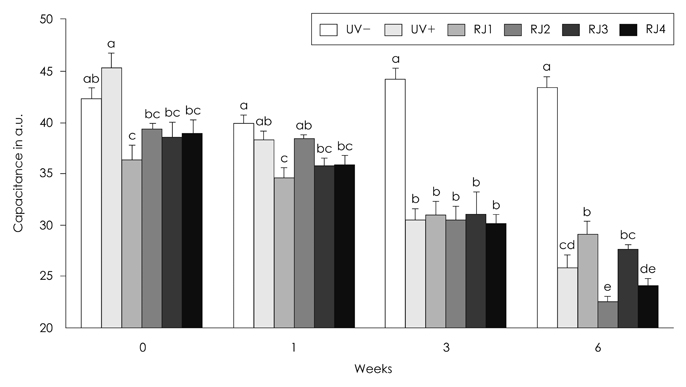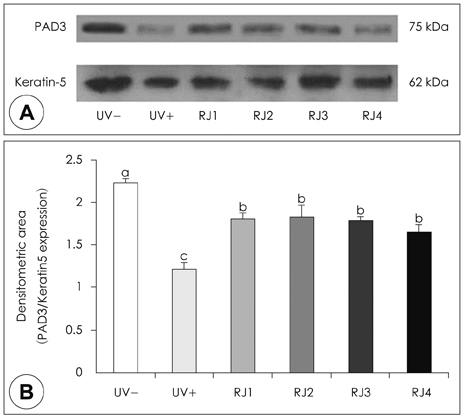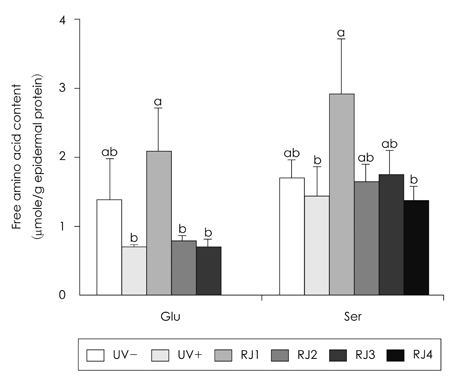Korean J Nutr.
2013 Apr;46(2):109-118. 10.4163/kjn.2013.46.2.109.
Dietary effect of royal jelly supplementation on epidermal levels of hydration, filaggrins, free amino acids and the related enzyme expression in UV irradiated hairless mice
- Affiliations
-
- 1Department of Medical Nutrition, Graduate School of East-West Medical Science, Kyung Hee University, Yongin 446-701, Korea. choyunhi@khu.ac.kr
- 2Department of Agricultural Biology, National Institute of Agricultural Science and Technology, Suwon 441-100, Korea.
- KMID: 2269388
- DOI: http://doi.org/10.4163/kjn.2013.46.2.109
Abstract
- Ultraviolet (UV) irradiation reduces epidermal hydration, which is paralleled by the reduction of natural moisturizing factors (NMFs). Of various NMFs, free amino acids (AAs) are major constituents generated by filaggrin degradation. In this study, we attempted to determine whether dietary supplementation of royal jelly (RJ) in UV-irradiated mice can alters epidermal levels of hydration, filaggrins, and free AAs as well as of peptidylarginine deiminase-3 (PAD3), an enzyme involved in filaggrin degradation processes. Albino hairless mice were fed either a control diet (group UV+: UV irradiated control) or diets with 1% RJ harvested from different areas in Korea (groups RJ1, RJ2, and RJ3) or imported from China (group RJ4) for six weeks in parallel with UV irradiation. A normal control group (group UV-) was fed a control diet without UV irradiation for six weeks. Reduced epidermal levels of hydration, total filaggrins, and PAD3 were observed in group UV+; in group RJ1, these levels were increased to a level similar to that of group UV-. In addition, profilaggrins, two repeat intermediates (2RI), a precursor with two filaggrin repeats, and filaggrin were increased. Although no alteration of AAs was observed in any of the groups, and glutamate and serine, major AAs of NMF in group RJ1 were higher than in group UV+. Despite the increased levels of PAD3, epidermal levels of hydration, filaggrins, glutamate, and serine in groups RJ2, RJ3, and RJ4 were similar to those in group UV+. Dietary supplementation of RJ1 improves epidermal hydration in parallel with enhanced expression and degradation of filaggrin, but not by increased protein expression of PAD3, along with increased generation of glutamate and serine.
Keyword
MeSH Terms
Figure
Cited by 2 articles
-
Dietary effect of green tea extract on hydration improvement and metabolism of free amino acid generation in epidermis of UV-irradiated hairless mice
Sumin Choi, Jihye Shin, Bomin Lee, Yunhi Cho
J Nutr Health. 2016;49(5):269-276. doi: 10.4163/jnh.2016.49.5.269.Dietary effect of green tea extract on epidermal levels of skin pH related factors, lactate dehydrogenase protein expression and activity in UV-irradiated hairless mice
Bomin Lee, Jongyei Kim, Jaesung Hwang, Yunhi Cho
J Nutr Health. 2016;49(2):63-71. doi: 10.4163/jnh.2016.49.2.63.
Reference
-
1. Brown SJ, McLean WH. Eczema genetics: current state of knowledge and future goals. J Invest Dermatol. 2009; 129(3):543–552.
Article2. Elias PM. Stratum corneum defensive functions: an integrated view. J Invest Dermatol. 2005; 125(2):183–200.
Article3. Rawlings AV, Harding CR. Moisturization and skin barrier function. Dermatol Ther. 2004; 17:Suppl 1. 43–48.
Article4. Verdier-Sévrain S, Bonté F. Skin hydration: a review on its molecular mechanisms. J Cosmet Dermatol. 2007; 6(2):75–82.
Article5. Coderch L, López O, de la Maza A, Parra JL. Ceramides and skin function. Am J Clin Dermatol. 2003; 4(2):107–129.
Article6. Steven AC, Steinert PM. Protein composition of cornified cell envelopes of epidermal keratinocytes. J Cell Sci. 1994; 107(Pt 2):693–700.
Article7. Clar EJ, Fourtanier A. Pyrrolidone carboxylic acid and the skin. Int J Cosmet Sci. 1981; 3(3):101–113.8. Kezic S, Kammeyer A, Calkoen F, Fluhr JW, Bos JD. Natural moisturizing factor components in the stratum corneum as biomarkers of filaggrin genotype: evaluation of minimally invasive methods. Br J Dermatol. 2009; 161(5):1098–1104.
Article9. Katagiri C, Sato J, Nomura J, Denda M. Changes in environmental humidity affect the water-holding property of the stratum corneum and its free amino acid content, and the expression of filaggrin in the epidermis of hairless mice. J Dermatol Sci. 2003; 31(1):29–35.
Article10. Rawlings AV, Scott IR, Harding CR, Bowser PA. Stratum corneum moisturization at the molecular level. J Invest Dermatol. 1994; 103(5):731–741.11. Tabachnick J, LaBadie JH. Studies on the biochemistry of epidermis. IV. The free amino acids, ammonia, urea, and pyrrolidone carboxylic acid content of conventional and germ-free albino guina pig epidermia. J Invest Dermatol. 1970; 54(1):24–31.
Article12. Scott IR, Harding CR, Barrett JG. Histidine-rich protein of the keratohyalin granules. Source of the free amino acids, urocanic acid and pyrrolidone carboxylic acid in the stratum corneum. Biochim Biophys Acta. 1982; 719(1):110–117.13. Jacobson TM, Yüksel KU, Geesin JC, Gordon JS, Lane AT, Gracy RW. Effects of aging and xerosis on the amino acid composition of human skin. J Invest Dermatol. 1990; 95(3):296–300.
Article14. Fleckman P, Dale BA, Holbrook KA. Profilaggrin, a high-molecular-weight precursor of filaggrin in human epidermis and cultured keratinocytes. J Invest Dermatol. 1985; 85(6):507–512.
Article15. Sandilands A, Sutherland C, Irvine AD, McLean WH. Filaggrin in the frontline: role in skin barrier function and disease. J Cell Sci. 2009; 122(Pt 9):1285–1294.
Article16. Presland RB. Function of filaggrin and caspase-14 in formation and maintenance of the epithelial barrier. Dermatol Sin. 2009; 27(1):1–14.17. Senshu T, Akiyama K, Nomura K. Identification of citrulline residues in the V subdomains of keratin K1 derived from the cornified layer of newborn mouse epidermis. Exp Dermatol. 1999; 8(5):392–401.
Article18. Kanno T, Kawada A, Yamanouchi J, Yosida-Noro C, Yoshiki A, Shiraiwa M, Kusakabe M, Manabe M, Tezuka T, Takahara H. Human peptidylarginine deiminase type III: molecular cloning and nucleotide sequence of the cDNA, properties of the recombinant enzyme, and immunohistochemical localization in human skin. J Invest Dermatol. 2000; 115(5):813–823.
Article19. Thulin CD, Walsh KA. Identification of the amino terminus of human filaggrin using differential LC/MS techniques: implications for profilaggrin processing. Biochemistry. 1995; 34(27):8687–8692.
Article20. McGrath JA, Uitto J. The filaggrin story: novel insights into skin-barrier function and disease. Trends Mol Med. 2008; 14(1):20–27.
Article21. Harding CR, Watkinson A, Rawlings AV, Scott IR. Dry skin, moisturization and corneodesmolysis. Int J Cosmet Sci. 2000; 22(1):21–52.
Article22. Koyama J, Horii I, Kawasaki K, Nakayama Y, Morikawa Y, Mitsui T. Free amino acids of stratum corneum as a biochemical marker to evaluate dry skin. J Soc Cosmet Chem. 1984; 35(4):183–195.23. Kim H, Lim YJ, Park JH, Cho Y. Dietary silk protein, sericin, improves epidermal hydration with increased levels of filaggrins and free amino acids in NC/Nga mice. Br J Nutr. 2012; 108(10):1726–1735.
Article24. Legat FJ, Wolf P. Photodamage to the cutaneous sensory nerves: role in photoaging and carcinogenesis of the skin? Photochem Photobiol Sci. 2006; 5(2):170–176.
Article25. Helfrich YR, Sachs DL, Voorhees JJ. Overview of skin aging and photoaging. Dermatol Nurs. 2008; 20(3):177–183.26. Haratake A, Uchida Y, Schmuth M, Tanno O, Yasuda R, Epstein JH, Elias PM, Holleran WM. UVB-induced alterations in permeability barrier function: roles for epidermal hyperproliferation and thymocyte-mediated response. J Invest Dermatol. 1997; 108(5):769–775.
Article27. Horii I, Nakayama Y, Obata M, Tagami H. Stratum corneum hydration and amino acid content in xerotic skin. Br J Dermatol. 1989; 121(5):587–592.
Article28. Viuda-Martos M, Ruiz-Navajas Y, Fernández-López J, Pérez-Alvarez JA. Functional properties of honey, propolis, and royal jelly. J Food Sci. 2008; 73(9):R117–R124.
Article29. Kim JK, Son JH, Oh HS. Analysis of organic acids in honey and royal jelly. Korean J Apic. 1989; 4(2):105–111.30. Kim JG, Son JH. Analysis of amino acids in royal jelly. Korean J Apic. 1991; 6(2):76–80.31. Kim J, Lee Y, Cho Y. Effects of dietary royal jelly on epidermal generation of ceramides from acidic sphingomyelin and glucosylceramides in UV-irradiated hairless mice. Curr Top Nutraceutical Res. 2013; Forthcoming.32. Kang TH, Park HM, Kim YB, Kim H, Kim N, Do JH, Kang C, Cho Y, Kim SY. Effects of red ginseng extract on UVB irradiation-induced skin aging in hairless mice. J Ethnopharmacol. 2009; 123(3):446–451.
Article33. Ginger RS, Blachford S, Rowland J, Rowson M, Harding CR. Filaggrin repeat number polymorphism is associated with a dry skin phenotype. Arch Dermatol Res. 2005; 297(6):235–241.
Article34. Nachat R, Méchin MC, Takahara H, Chavanas S, Charveron M, Serre G, Simon M. Peptidylarginine deiminase isoforms 1-3 are expressed in the epidermis and involved in the deimination of K1 and filaggrin. J Invest Dermatol. 2005; 124(2):384–393.
Article35. Tarcsa E, Marekov LN, Mei G, Melino G, Lee SC, Steinert PM. Protein unfolding by peptidylarginine deiminase. Substrate specificity and structural relationships of the natural substrates trichohyalin and filaggrin. J Biol Chem. 1996; 271(48):30709–30716.36. Kambayashi H, Yamashita M, Odake Y, Takada K, Funasaka Y, Ichihashi M. Epidermal changes caused by chronic low-dose UV irradiation induce wrinkle formation in hairless mouse. J Dermatol Sci. 2001; 27:Suppl 1. S19–S25.
Article37. Matsumura Y, Ananthaswamy HN. Toxic effects of ultraviolet radiation on the skin. Toxicol Appl Pharmacol. 2004; 195(3):298–308.
Article38. Kim H, Park KH, Yeo JH, Lee KG, Jeong DH, Kim SH, Cho Y. Dietary effect of silk protein sericin or fibroin on plasma and epidermal amino acid concentration of NC/Nga mice. Korean J Nutr. 2006; 39(6):520–528.39. Wolfersberger MG, Tabachnick J, Finkelstein BS, Levin M. L-pyrrolidone carboxylic acid content in mammalian epidermis and other tissues. J Invest Dermatol. 1973; 60(5):278–281.
Article40. Ramadan MF, Al-Ghamdi A. Bioactive compounds and health-promoting properties of royal jelly: a review. J Funct Foods. 2012; 4(1):39–52.
Article41. Cho Y. Development of royal jelly as a functional dietary source for anti-aging and anti-oxidation of skin. 2009. Suwon: Rural Development Administration.42. Kim JG, Son JH, Lee SH. Comparative research on the ingredient or royal jelly produced in south and north Korea. Korean J Apic. 1993; 8(2):170–178.43. Park HM, Cho MH, Cho Y, Kim SY. Royal jelly increases collagen production in rat skin after ovariectomy. J Med Food. 2012; 15(6):568–575.
Article
- Full Text Links
- Actions
-
Cited
- CITED
-
- Close
- Share
- Similar articles
-
- Dietary effect of green tea extract on hydration improvement and metabolism of free amino acid generation in epidermis of UV-irradiated hairless mice
- Dietary effect of green tea extract on epidermal levels of skin pH related factors, lactate dehydrogenase protein expression and activity in UV-irradiated hairless mice
- Dietary effect of red ginseng extracts mixed with torilis fructus and corni fructus on the epidermal levels of ceramides and ceramide related enzyme proteins in uv-induced hairless mice
- Dietary Effect of Silk Protein Sericin or Fibroin on Plasma and Epidermal Amino Acid Concentration of NC/Nga Mice
- Topical Application of Selenium Can Significantly Relieve UV-induced Skin Aging in Hairless Mice





